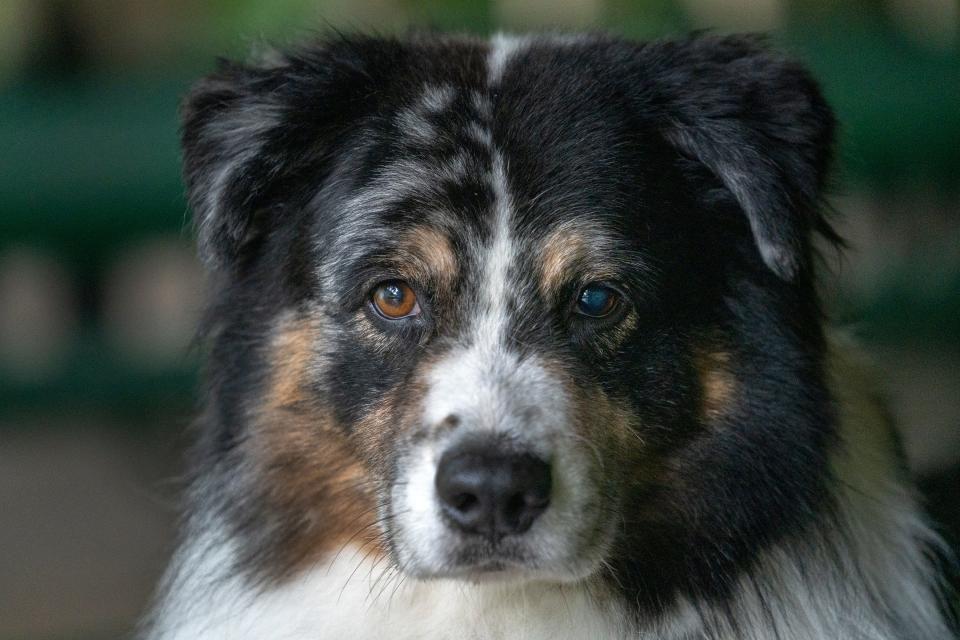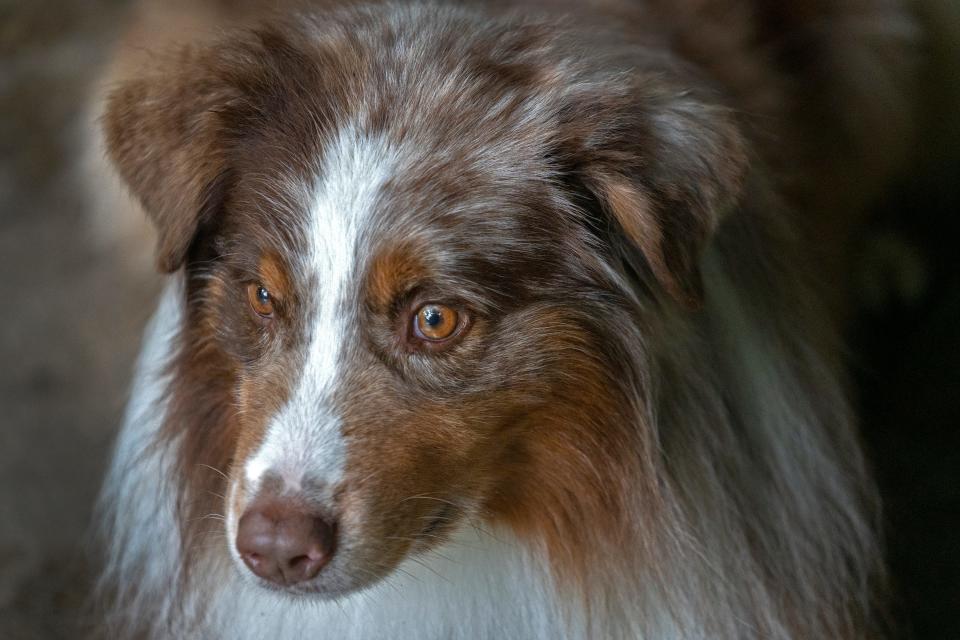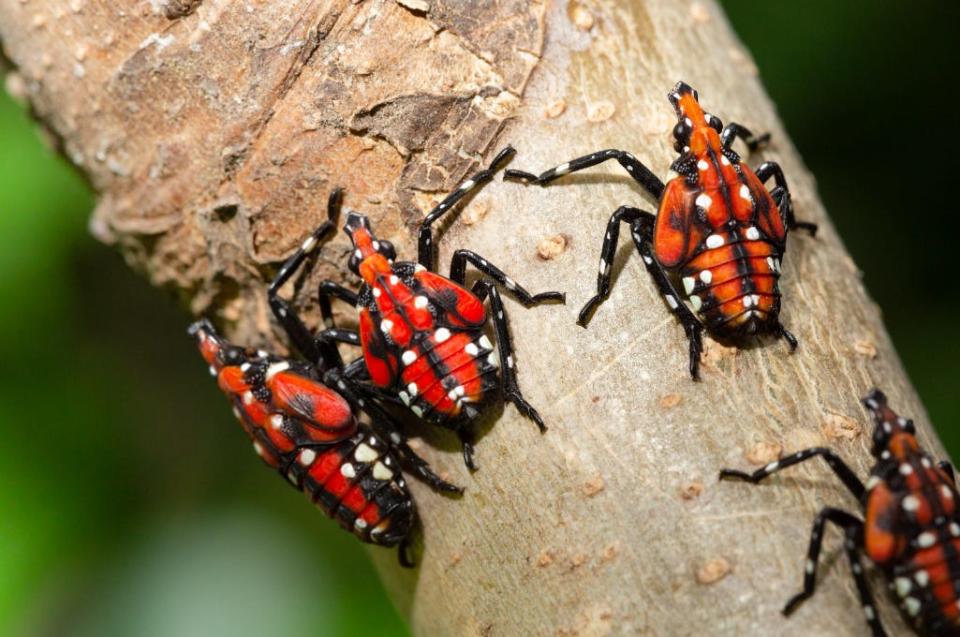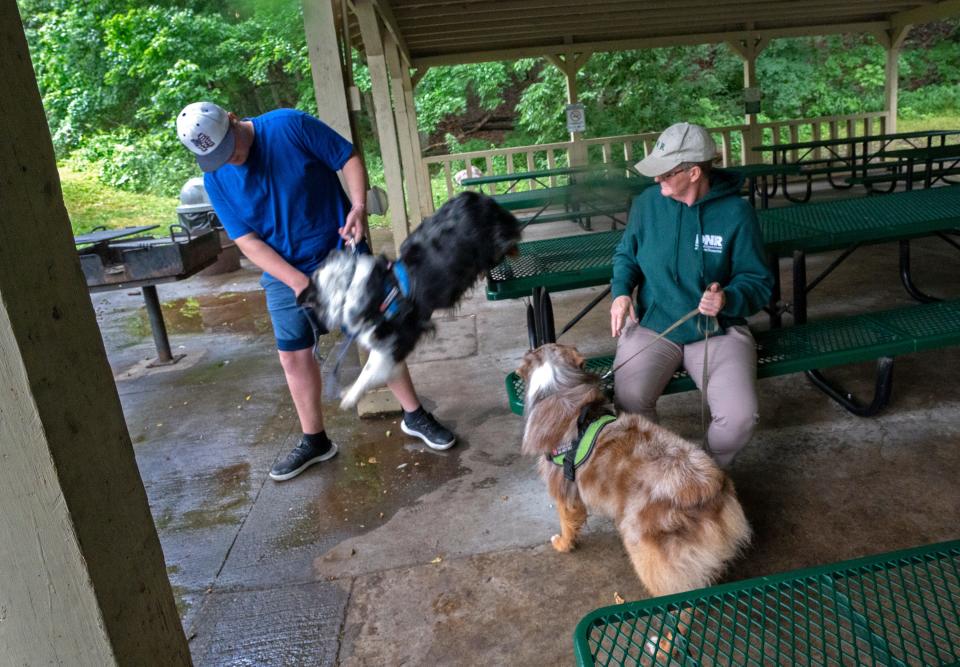A pair of lovable dogs are on the frontline of Indiana's fight against a new invasive pest
Que, a 10-year-old Australian shepherd, sits patiently outside a shelter at a West Lafayette park eyeing Kallie Bontrager.
Bontrager is holding a treat in one hand and a scented plastic tube in the other.
When Que sniffs the tube, Bontrager gives him a treat.
Sniff. Treat.
Sniff. Treat.
It's a typical training tactic, but this isn't your typical dog training.
Que is learning how help stop the spread of an invasive pest that is a growing threat to Indiana — the spotted lanternfly. Indiana is an emerging battlefront against the invasive plant hopper, which can devastate vineyards and harm other native plants and trees.

Que and his brother, Epic, 5, are participants in an innovative new approach to eradicating the pest first found in Indiana in 2021.
Bontrager is a nursery inspector with the Indiana Department of Natural Resources. She spends her days traveling to big-box garden centers and small nurseries to make sure there are no invasive insects or diseases on plants being sold to customers.
When she's not working for the state, the La Porte woman's trains and shows dogs.
Invasive species: 10 to watch out for across Indiana
So it was only logical that she decided to combine her skills to help fight against the pest. Her unique action was inspired by a video of a similar approach in Pennsylvania, where the species is more prolific.
“That really caught my attention because this is the newest upcoming threat and I thought we’re probably going to see it here,” Bontrager said. “I asked if they mind if I try and train my dogs to do this."
The DNR gave her the go-ahead.
Other states have purchased conservation canines trained for this work, but there are constraints on state-owned dogs, such as how they’re kenneled. For Bontrager and her dogs, the new endeavor is a win-win project.
“Now my dogs get to go to work with me all the time,” Bontrager said.
The trio trains almost every day. Bontrager set up crates and fans in her vehicle and will stop at parks to train when she’s done with her nursery inspections for the day.
How are the dogs trained?
Bontrager began training Que and Epic last year. The scent is paired with food so it becomes a habit: when they find it in the field, they’re rewarded with a treat and praise.
For Bontrager, the process started with a lot of learning on the fly. The odor from insects is not perceptible to humans, so she started by making sure Que and Epic knew how to search for odors, then moved on to the scent of the plant hopper's egg mass.
Initially, they used egg masses that had already hatched, but Bontrager soon learned those have a different odor than live egg masses. She obtained eggs that had not hatched, but because those cannot be taken outside, she had to kill off the eggs with the help from a lab in Purdue University. The lab could put the eggs into a freezer that reached -80 Celsius and would keep them there for 96 hours.
Que and Epic showed real progress training with these but started to struggle in the field as they transitioned from trying to find the frozen samples to the actual masses in the wild.

The problem stumped Bontrager until she reached out to a conservation dog trainer in North Carolina. That person put her in touch with someone in New York working on the same invasive insect problem.
“I was just not figuring out why they couldn’t figure it out in the field,” Bontrager said.
It turns out, there is even a difference in the scents of a frozen egg mass and a live mass in nature. This is when she discovered Getxent, a type of plastic tube that absorbs and hold odors for about six months.
It was a breakthrough, and Bontrager found a biology professor, Collin Hobbs at Huntington University, who was willing to help.
Que and Epic now train on tubes that have been stored with live egg masses. The exposure times range from 12 to 48 hours. The longer time periods result in the more pungent tube, which are more easily discovered.
Bontrager will set the tubes out and train the dogs one at a time for short, 10– to 15-minute sessions.
At Happy Hollow Park on a recent morning, Que is the first to try to find three tubes spread out under a shelter housing picnic tables.
Bontrager puts on Que’s working harness, offers a separate tube so Que knows what to smell for and gives him his treats.
“When the harness goes on," Bontrager said before leading Que into the shelter, "the dogs know it’s time to work.”
“Find the bugs,” she prompts.
In less than a minute, Que catches the odor. He yips excitedly at the smell until zeroing in on the spot and paws the scent tube.
“Yes! Good job!" Bontrager said before returning him to his crate. "Good Boy!”
While Que is confident, Bontrager said Epic is younger and a little more uncertain. He gets worried if he doesn’t succeed right away.
Epic leaps from his crate ready for his turn, and takes his time, combing the shelter more thoroughly. Epic's nose doesn't seem to leave the ground as he checks every nook and cranny near a handrail. Where Que took broad steps, Epic is surveying the scents under the shelter inch by inch, searching for a whiff of egg mass.
Epic finds his first tube quickly, wags his tail and gets his treat before resuming the diligent search for the next scent.
He finds all three, gets more treats and retires for the day back in the back of the van.
It’s a short training session, but Bontrager said it’s a lot of work for the dogs. She doesn’t want to exhaust them by going for too long.
“That’ll do,” Bontrager tells her dogs as they finish.
Attacking the bugs from all directions
A spotted lanternfly won’t start laying eggs until the fall, so Que and Epic have time to shore up their skills this summer.
The leaf hoppers are not yet widespread in Indiana, being discovered only in the city of Huntington, just southwest of Fort Wayne, and Switzerland County along the Ohio River in south eastern Indiana. The first populations in the state were identified in July 2021.
At ground zero of the invasion, in Huntington, Vince Burkle is also a nursery inspector with the DNR. He's on the ground at the head of the state agency's efforts to eradicate the pest, which he says threatens a growing agricultural industry.
“Spotted lanternfly feed in large numbers and if they get on grape vines, they reduce the vitality and winter hardiness of grapes, and also effect the yield of the fruit,” Burkle said.
Most of the time, the insect’s low populations means the invasive species is going to remain undetected by humans, he said.

“The goal of the canine units is to really try to give us a way to detect spotted lanternfly earlier than we detect it,” Burkle said. “That makes management much easier.”
Bontrager has invited Burkle to go out with the dogs a few times, and Burkle said they’re doing a good job.
“Like anytime you’re training a dog you have to reinforce and keep training them,” he said. “They’ve been very successful.”
Bontrager recalled one instance where the dogs were able to detect an egg mass in the wild, but she herself could not find it.
Spotted lanternfly can lay eggs above eye level, so they can be tricky to find.
“That’s the problem we run into is trusting when they are saying it’s here,” Bontrager said. “We need to come back and look again or have someone else come out and take a closer look.”
Burkle said once a dog identifies an egg mass in the wild, the DNR will document the site. The department puts together surveys to see how extensive the problem is and track whether the population is spreading.
Then, the teams work on destroying those eggs.
DNR staff spent time this past winter scraping egg masses from trees in the two areas the species is known inhabit. So far, Burkle said, they’ve scraped and destroyed more than 16,000 egg masses, most of them in the Huntington area.
“That’s 670,000 eggs we feel like we have eliminated,” he said. “It sounds like a lot, but there is quite a bit more work to do there.”
The leaf hoppers main food source is the Tree of Heaven, so the DNR will treat wood lots with insecticides to kill of the spotted lanternfly in its younger life stages. This summer, the department plans to conduct an outreach and education program to alert residents to the problem.
The saying now is: “If you see it, smash it, but also let us know.”

If anyone thinks they might have spotted an egg mass or any life stage of the spotted lanternfly, they can alert DNR via email at depp@dnr.in.gov or by calling 866-NOEXOTIC (663-9684).
Send along the location of the potential sighting, contact information so someone at the department can reach out, and take photos.
“Knowing that information," Burkle said, "allows us to notify the appropriate inspector and send them out to take a look."
IndyStar's environmental reporting project is made possible through the generous support of the nonprofit Nina Mason Pulliam Charitable Trust.
This article originally appeared on Indianapolis Star: Dogs who sniff out invasive pest in Indiana paid in treats and praise

